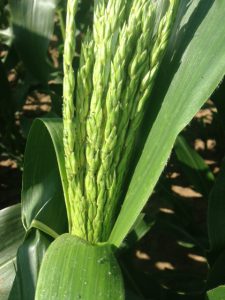Sweet Corn
European corn borer (ECB) moth catches remain low. Feeding signs in whorl corn are rare. There will be no map in this edition. Second generation feeding is often obscured by fall armyworm (FAW) feeding. Once plants hit full tassel, any ECB larvae present will move downward on the stalk and re-enter the plant near the area where ears are forming. This can result in direct injury to the ear. Growers should consider an insecticide application at the full tassel stage to target ECB larvae as they migrate downward. This application can eliminate larvae that have escaped any earlier insecticide applications.
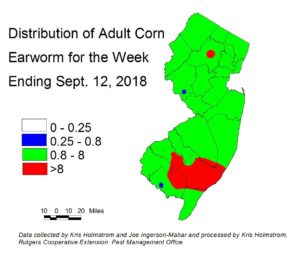 Corn earworm (CEW) catches have decreased somewhat over the past week in black light traps. This is likely due to cooler night time temperatures. We would expect numbers to rebound somewhat with a warming trend, and possibly increase significantly, depending on the trajectory of the tropical system now approaching the lower mid-Atlantic coast. The CEW pheromone trap network in the southern counties is still capturing high numbers of moths in several locations (see CEW blacklight map at left, and pheromone trap map at right),
Corn earworm (CEW) catches have decreased somewhat over the past week in black light traps. This is likely due to cooler night time temperatures. We would expect numbers to rebound somewhat with a warming trend, and possibly increase significantly, depending on the trajectory of the tropical system now approaching the lower mid-Atlantic coast. The CEW pheromone trap network in the southern counties is still capturing high numbers of moths in several locations (see CEW blacklight map at left, and pheromone trap map at right), 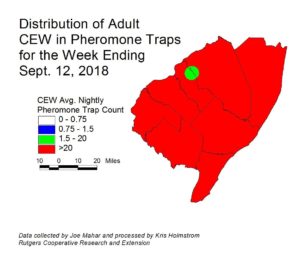 and while numbers overall are slightly down, the broad 3-day range leaves the map largely the same as last week. There are many fewer pheromone traps than blacklight traps. This results in much broader colored patches on the pheromone maps. The green area on the blacklight map indicates an approximate 3-day silk spray schedule. Red areas on this map are extremely high local populations, and there should be no deviation from the 3-day silk schedule. On the pheromone map, the red area indicates a solid 3-day schedule depending on location.
and while numbers overall are slightly down, the broad 3-day range leaves the map largely the same as last week. There are many fewer pheromone traps than blacklight traps. This results in much broader colored patches on the pheromone maps. The green area on the blacklight map indicates an approximate 3-day silk spray schedule. Red areas on this map are extremely high local populations, and there should be no deviation from the 3-day silk schedule. On the pheromone map, the red area indicates a solid 3-day schedule depending on location.
The highest nightly black light trap catches of CEW for the week ending 9/12/18 are as follows:
| East Vineland 41 | Woodstown 7 | Allamuchy 4 |
| Denville 12 | Folsom 6 | Farmingdale 4 |
| Crosswicks 8 | Tabernacle 6 | Long Valley 4 |
| Downer 7 | Hackettstown 5 | Newton 4 |
The highest nightly pheromone trap catches of CEW for the week ending 9/12/18 are as follows:
| Woodstown 138 | Beckett 29 |
| East Vineland 98 | Berlin 18 |
| Monroeville 59 | Snyder Farm (Hunterdon Co.) 14 |
| Pedricktown 56 | Belvidere (Warren Co.) 7 |
| Green Creek 40 | Springdale 5 |
Silking Spray Schedules*:
South – 3 days
Central – 3 days
North – 3 days
*These recommendations are based on regional catches. Adhere to tighter spray schedules if indicated by local trap catches.
Fall Armyworm
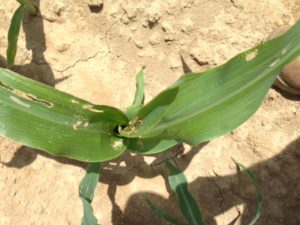 Fall armyworm (FAW) infestations remain light, although moth numbers have increased in black light traps in central NJ. Southern pheromone trap catches remain low. With limited whorl stage corn left, and tight silk schedules required to limit CEW injury, it is unlikely that FAW will become a serious problem for the remainder of the sweet corn growing season. Continue scouting regularly for this pest. Look for significant injury in whorls, with all damage leading directly into the center of the plant (see photo at left). FAW larvae consume lots of tissue, and grow rapidly . Be sure to check seedling stage plantings as well, as FAW will attach even small plants. Consider treating if plants infested with FAW alone, or in combination with ECB exceed 12%. FAW is resistant to synthetic pyrethroid insecticides. Effective materials include those in IRAC groups 5 (Radiant, Entrust (OMRI approved)), and 28 (Coragen, Exirel).
Fall armyworm (FAW) infestations remain light, although moth numbers have increased in black light traps in central NJ. Southern pheromone trap catches remain low. With limited whorl stage corn left, and tight silk schedules required to limit CEW injury, it is unlikely that FAW will become a serious problem for the remainder of the sweet corn growing season. Continue scouting regularly for this pest. Look for significant injury in whorls, with all damage leading directly into the center of the plant (see photo at left). FAW larvae consume lots of tissue, and grow rapidly . Be sure to check seedling stage plantings as well, as FAW will attach even small plants. Consider treating if plants infested with FAW alone, or in combination with ECB exceed 12%. FAW is resistant to synthetic pyrethroid insecticides. Effective materials include those in IRAC groups 5 (Radiant, Entrust (OMRI approved)), and 28 (Coragen, Exirel).
B.t Sweet Corn Sentinel Plot Evaluations
A sweet corn sentinel plot containing non-engineered types (Providence and Obsession I) as well as genetically engineered types (Attribute I – BC0805, Attribute II – Remedy, and Performance Series – Obsession II) was evaluated at Snyder Farm in Hunterdon County last week. No insecticidal sprays were applied to this planting. The plot was evaluated for CEW and other larval damage at market maturity. The vast majority of larval injury was from CEW although there were several ECB larvae found in non-engineered types. These results again indicate that CEW has yet to develop resistance to the toxin found in Attribute II types, while this pest has significant resistance to other genetically engineered types.
The percentage of clean ears per variety are as follows:
Remedy – 100%
Obsession II – 73%
BC 0805 – 58%
Obsession I – 41%
Providence – 36%
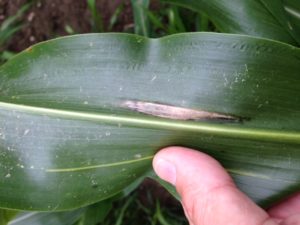 Northern corn leaf blight (NCLB) remains a significant threat to late sweet corn. This foliar disease of corn causes elongated, gray lesions on the leaves (see photo at left). NCLB attacks older tissue first, but can move further up the plant when wet conditions permit spore production and germination. Ultimately, NCLB can cause unsightly lesions on ear husks and even poor ear size if is uncontrolled. If NCLB is detected in sweet corn prior to silking, one or more fungicide applications may be warranted. See the Sweet Corn section of the 2018 Commercial Vegetable Recommendations for useful fungicides.
Northern corn leaf blight (NCLB) remains a significant threat to late sweet corn. This foliar disease of corn causes elongated, gray lesions on the leaves (see photo at left). NCLB attacks older tissue first, but can move further up the plant when wet conditions permit spore production and germination. Ultimately, NCLB can cause unsightly lesions on ear husks and even poor ear size if is uncontrolled. If NCLB is detected in sweet corn prior to silking, one or more fungicide applications may be warranted. See the Sweet Corn section of the 2018 Commercial Vegetable Recommendations for useful fungicides.
Corn leaf aphid (photo at right) is a fairly common insect pest of late stage sweet corn at this time, particularly if pyrethroid insecticides have been used. To help manage this insect, and prevent it from becoming a possible contaminant at harvest, consider including Lannate early in the silk spray schedule. Additionally, the neonocotinoid Assail is labeled for aphid control on sweet corn and is much less toxic to bees than other neonicitonoids. Assail has no caterpillar activity, so it must be in addition to the worm material that is used.
Pepper Weevil
No weevils have been trapped outside of the Hammonton area. The concern for weevils drops in mid-September as some fields will begin to be taken out of production.
Brown marmorated stink bug (BMSB)
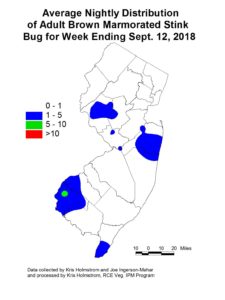 BMSB catches in black light traps have decreased somewhat from the previous week. Activity (as indicated by black light trap catches) seems to rise with very warm, humid night conditions. At the present time, the heaviest catches are in Monmouth and Salem counties, although these occurred primarily at the end of the previous week. While this pest has not had serious impact on vegetable crops like peppers in recent years, it is still a significant pest of tree fruits.
BMSB catches in black light traps have decreased somewhat from the previous week. Activity (as indicated by black light trap catches) seems to rise with very warm, humid night conditions. At the present time, the heaviest catches are in Monmouth and Salem counties, although these occurred primarily at the end of the previous week. While this pest has not had serious impact on vegetable crops like peppers in recent years, it is still a significant pest of tree fruits.
The highest nightly trap catches of BMSB for the week ending 9/12/18 are as follows:
| Woodstown 6 | Green Creek 2 | Belvidere 1 |
| Clinton 4 | Pedricktown 2 | Centerton 1 |
| Farmingdale 3 | Princeton 2 | East Vineland 1 |
| Allentown 2 | South Branch 2 | Oldwick 1 |
Pumpkins and Winter Squash
All growers should be applying appropriate downy mildew (DM) fungicides on all cucurbit plantings now. CDM has been found on pumpkins and other cucurbit crops throughout the state. For detailed CDM forecasts, see the following website: http://cdm.ipmpipe.org/ All growers are encouraged to check this website at least once a week. NJ was considered to be at high risk of infection from outside areas through Tuesday of this week, but with most fields now infected and/or being protected, there is little change necessary. Heavy dews now occurring will increase in-field spread in currently infected fields. IPM scouts frequently detect DM lesions on leaves, but when appropriate fungicides are being used, these lesions are not actively producing spores. For a list of DM specific fungicides, see the Pumpkin and Winter Squash section in the 2018 Commercial Vegetable Recommendations. These products should be applied regularly until the fruit “handles” are mature and harvests are to begin with in 1-2 weeks.
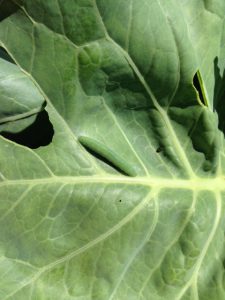 Late summer cole crop plantings are experiencing infestations, primarily from imported cabbageworm (ICW) (photo at left) and diamondback moth (DBM) larvae (photo at lower right). While both are damaging to these crops, DBM is more difficult to manage, as it is quite resistant to synthetic pyrethroid insecticides. DBM is effectively managed (along with all other caterpillar pests) with insecticides in the IRAC class 5 (Radiant, Entrust (OMRI approved)), and class 28 (Coragen, Exirel). DBM larvae are very small and are tapered toward both ends. They thrash violently when disturbed. ICW larvae grow larger and have a covering of velvety hairs as they grow. Check 5 consecutive plants each in 10 random sites within the planting. Consider treating if 10% or more
Late summer cole crop plantings are experiencing infestations, primarily from imported cabbageworm (ICW) (photo at left) and diamondback moth (DBM) larvae (photo at lower right). While both are damaging to these crops, DBM is more difficult to manage, as it is quite resistant to synthetic pyrethroid insecticides. DBM is effectively managed (along with all other caterpillar pests) with insecticides in the IRAC class 5 (Radiant, Entrust (OMRI approved)), and class 28 (Coragen, Exirel). DBM larvae are very small and are tapered toward both ends. They thrash violently when disturbed. ICW larvae grow larger and have a covering of velvety hairs as they grow. Check 5 consecutive plants each in 10 random sites within the planting. Consider treating if 10% or more 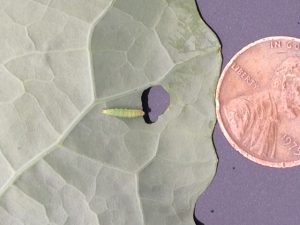 leafy cole crops are infested at any stage, or in heading types in the 0-9 true leaf stage. In heading types from 9 leaf to early head, a level of 20% plants infested may be acceptable. As heads form, the threshold should drop to 5% plants infested with any larvae, to protect the marketable portion of the plant.
leafy cole crops are infested at any stage, or in heading types in the 0-9 true leaf stage. In heading types from 9 leaf to early head, a level of 20% plants infested may be acceptable. As heads form, the threshold should drop to 5% plants infested with any larvae, to protect the marketable portion of the plant.
